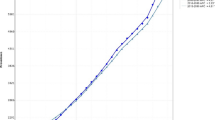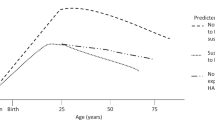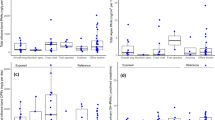Abstract
BACKGROUND:
We have previously found a quite strong interplay between occupational airborne pollutants, ABO phenotypes, and risk of ischaemic heart disease (IHD), with long-term exposure being associated with a significantly increased risk among men with phenotype O, and not among men with other ABO phenotypes. We suggested that the biological pathway could be a stronger systemic inflammatory response in men with blood group O. Several inflammatory mediators likely to increase the risk of IHD have recently been linked also to obesity, suggesting that long-term exposure to airborne pollutants might play a role in the aetiology of obesity. Accordingly, we tested the hypothesis that long-term occupational exposure to airborne pollutants would be more strongly associated with obesity in men with phenotype O than in men with other ABO phenotypes.
DESIGN:
Cross-sectional exposure–response study taking into account potential confounders.
SETTING:
The Copenhagen Male Study.
SUBJECTS:
A total of 3290 men aged 53–74 y.
MAIN OUTCOME MEASURE:
Prevalence of obesity (BMI ≥30 (kg/m2)).
RESULTS:
Overall, no differences were found in the prevalence of obesity between men with the O phenotype (n=1399) and men with other phenotypes (n=1891), 8.6 and 9.0%. However, only among men with the O phenotype was long-term occupational exposure (at least 5 y of frequent exposure) to various respirable airborne pollutants: dust, asbestos, soldering fumes, welding fumes, organic solvents, fumes from lacquer, paint or varnish, toxic components, breath irritants, stench or strongly smelling products, and irritants (other than breath irritants or contagious components) associated with an increased prevalence of obesity. Statistically, the strongest univariate associations were found for asbestos exposure, welding fumes, and breath irritants. Odds ratios (95% confidence limits) for these factors were 3.7 (1.8–7.6), 2.7 (1.6–4.4), and 2.6 (1.5–4.4), respectively. This particular relationship of airborne exposures with obesity in men with phenotype O was supported in multivariate analysis including interaction terms and taking into account a number of potential confounders. In contrast, no gene–environment interactions with obesity were found with respect to ABO phenotypes and a number of nonrespirable exposures.
CONCLUSION:
The finding of a quite strong interplay between long-term exposure to airborne pollutants, ABO phenotypes, and risk of obesity may open up new possibilities for clarifying mechanisms underlying the global obesity epidemic.
This is a preview of subscription content, access via your institution
Access options
Subscribe to this journal
Receive 12 print issues and online access
$259.00 per year
only $21.58 per issue
Buy this article
- Purchase on Springer Link
- Instant access to full article PDF
Prices may be subject to local taxes which are calculated during checkout



Similar content being viewed by others
References
Suadicani P, Hein HO, Gyntelberg F . Airborne occupational exposure, ABO phenotype and risk of ischaemic heart disease in the Copenhagen Male Study. J Cardiovasc Risk 2002; 9: 191–198.
Seaton A, MacNee W, Donaldson K, Godden D . Particulate air pollution and acute health effects. Lancet 1995; 345: 176–178.
Sjögren B . Occupational exposure to dust, inflammation and ischaemic heart disease. Occup Environ Med 1997; 54: 466–469.
Brook RD, Franklin B, Cascio W, Hong Y, Howard G, Lipsett M, Luepker R, Mittleman M, Samet J, Smith Jr SC, Tager I . Expert Panel on Population and Prevention Science of the American Heart Association. Air pollution and cardiovascular disease: a statement for healthcare professionals from the Expert Panel on Population and Prevention Science of the American Heart Association. Circulation 2004; 109: 2655–2671.
Das UN . Is obesity an inflammatory condition? Nutrition 2001; 17: 953–966.
Yudkin JS, Kumari M, Humphries SE, Mohamed-Ali V . Inflammation, obesity, stress and coronary heart disease: is interleukin-6 the link? Atherosclerosis 2000; 148: 209–214.
Tremblay A, Pelletier C, Doucet E, Imbeault P . Thermogenesis and weight loss in obese individuals: a primary association with organochlorine pollution. Int J Obes Relat Metab Disord 2004; 28: 936–939.
Gyntelberg F . Physical fitness and coronary heart disease in male residents in Copenhagen aged 40–59. Dan Med Bull 1973; 20: 1–4.
Gyntelberg F . One- and two-years incidence of myocardial infarction in Copenhagen males aged 40–59. Dan Med Bull 1975; 22: 81–84.
Suadicani P, Hein HO, Gyntelberg F . Serum cotinine validated form of smoking does not account for social inequalities in risk of ischaemic heart disease: the Copenhagen Male Study—4 years' follow-up. Int J Epidemiol 1994; 23: 293–300.
Hein HO, Suadicani P, Gyntelberg F . Changes in physical activity level and risk of ischaemic heart disease. Scand J Med Sci Sports 1994; 4: 57–64.
Svalastoga K . Prestige, Class and Mobility. Münksgaard: Copenhagen; 1959.
Hansen EJ . Socialgrupper i Danmark. The Institute of Danish Social Science, Study No 48: Copenhagen; 1984.
Norusis MJ, SPSS Inc. SPSS for Windows: Base System Users Guide, release 7.5. SPSS: Chicago; 1997.
Norusis MJ, SPSS Inc. SPSS for Windows: Advanced Statistics, release 7.5. SPSS: Chicago; 1997.
Hosmer DW, Lemeshow S . Applied Logistic Regression. A Wiley-Interscience Publication: New York, USA; 1989.
Greenberg RS, Kleinbaum DG . Mathematical modelling strategies for the analysis of epidemiologic research. Ann Rev Public Health 1985; 6: 223–245.
Mourant AE, Kopec AC, Damaniewska-Sobcnoak K . The Distribution of the Human Blood Groups and Other Polymorphisms. Oxford University Press: London; 1976.
Hein HO, Suadicani P, Gyntelberg F . Mixed solvent exposure and cerebral symptoms among active and retired workers. Acta Neurol Scand 1990; 81: 97–102.
Suadicani P, Hein HO, Gyntelberg F . Do physical and chemical working conditions explain the association of social class with ischaemic heart disease? Atherosclerosis 1995; 113: 63–69.
Suadicani P, Hein HO, Meyer HW, Gyntelberg F . Exposure to cold and draught, alcohol consumption, and the NS-phenotype are associated with chronic bronchitis: an epidemiological investigation of 3387 men aged 53–75 years: the Copenhagen Male Study. Occup Environ Med 2001; 58: 160–164.
Alkout AM, Blackwell CC, Weir DM . Increased inflammatory responses of persons of blood groups O to Helicobacter pylori. J Infect Dis 2000; 181: 1364–1369.
Dandona P, Aljada A, Bandyopadhyay A . Inflammation: the link between insulin resistance, obesity and diabetes. Trends Immunol 2004; 25: 4–7.
Lockwood AH . Diabetes and air pollution [letter]. Diabetes Care 2002; 25: 1487–1488.
Author information
Authors and Affiliations
Corresponding author
Rights and permissions
About this article
Cite this article
Suadicani, P., Hein, H. & Gyntelberg, F. Airborne occupational exposure, ABO phenotype, and risk of obesity. Int J Obes 29, 689–696 (2005). https://doi.org/10.1038/sj.ijo.0802956
Received:
Revised:
Accepted:
Published:
Issue Date:
DOI: https://doi.org/10.1038/sj.ijo.0802956
Keywords
This article is cited by
-
Impact of ambient air pollution on obesity: a systematic review
International Journal of Obesity (2018)



